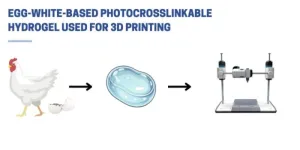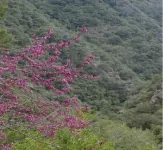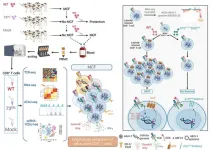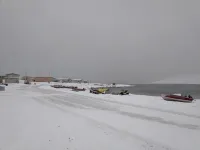(Press-News.org) Los Angeles, California – July 29, 2024 - Terasaki Institute scientists have created a cutting-edge technology inspired by nature by developing a novel bioink derived from egg whites or Egg White methacryloyl (EWMA). Bioinks are mainly used in 3D bioprinting to create artificial tissues. These natural or synthetic materials support living cells, aiding their adhesion, growth, and differentiation. They are essential for developing complex tissue structures for medical research, drug testing, and organ transplantation. This novel EWMA bioink represents a promising addition to this field, offering a unique combination of properties that address many challenges faced in tissue engineering.
The team created a photocrosslinkable bioink from egg whites through methacryloyl modification. This EWMA bioink offers several advantages that make it suitable for bioprinting applications. They provide abundant proteins, ensuring a nutrient-rich environment for cell growth. These bioinks exhibit excellent biocompatibility and bioactivity, crucial for successful tissue engineering.
The EWMA bioink exhibits properties such as flexibility that allow researchers to fine-tune the material's characteristics to match the specific requirements of multi-tissue structures that closely mimic natural biological systems. EWMA bioinks possess intrinsic antiviral and antibacterial properties. These inherent features provide an added layer of protection against potential infections, which is particularly valuable in medical applications.
The implications of this study extend far beyond the laboratory. EWMA bioinks could potentially be used to create more accurate tissue models for drug testing, reducing the need for animal trials. In the long term, this technology can contribute toward developing functional tissue replacements for regenerative medicine applications. In the words of Dr. Ali Khademhosseini, CEO at TIBI and a renowned expert in bioengineering: "This innovative approach to creating bioinks from egg whites demonstrates the immense potential of bio-inspired materials in tissue engineering. By harnessing readily available natural resources and enhancing them through clever chemical modifications, we're opening new avenues for personalized regenerative medicine. Such breakthroughs are crucial in our quest to develop more effective and accessible solutions for organ failure, cardiovascular disease, and cancer treatments."
As research advances, we anticipate further improvements and uses for EWMA bioink. This breakthrough showcases the innovative drive in tissue engineering and the potential of bio-inspired materials to tackle complex medical issues. The development of EWMA bioink marks a significant step towards more effective and versatile bioprinting techniques. As scientists continue exploring and expanding this technology, we may enter a new era in tissue engineering and regenerative medicine.
Authors: Mahboobeh Mahmoodi, Mohammad Ali Darabi, Neda Mohaghegh, Ahmet Erdem, Amir Ahari, Reza Abbasgholizadeh, Maryam Tavafoghi, Vahid Hosseini, Javed Iqbal, Reihaneh Haghniaz, Hossein Montazerian, Jamileh Jahangiry, Fatemeh Nasrolahi, Arshia Mirjafari, Erik Pagan, Mohsen Akbari, Hojae Bae, Johnson V. John, Hossein Heidari, Ali Khademhosseini, Alireza Hassani Najafabadi
Grant Information: MT would like to acknowledge financial support from Fonds de recherche du Québec- santé (FRQS).
For more information, please contact:
Stewart Han
Email: shan@terasaki.org
Alireza Hassani, Ph.D.
Email: hassania@terasaki.org
### END ###
About Terasaki Institute for Biomedical Innovation (TIBI):
The Terasaki Institute for Biomedical Innovation is a non-profit research organization dedicated to leveraging cutting-edge technology to address global health challenges. By fostering interdisciplinary collaborations and pushing the boundaries of innovation, TIBI aims to transform healthcare and improve lives worldwide.
END
Nature inspires a breakthrough: scientists develop revolutionary egg white-based bioink for advanced tissue engineering
Terasaki Institute scientists have created a cutting-edge technology inspired by nature
2024-07-29
ELSE PRESS RELEASES FROM THIS DATE:
California a botanical and climate change hot spot
2024-07-29
From coastal redwoods and Joshua trees to golden poppies and sagebrush, California is a global botanical hotspot. It’s also a place confronted with extreme heat, wildfires and crumbling coastlines. The state’s natural beauty and history of pioneering conservation efforts make it a test bed for protecting biodiversity in the face of current and future climate change, argues a study led by the University of California, Davis.
Published July 29 in Proceedings of the National Academy of Sciences, the study, “Climate Change and California’s Terrestrial Biodiversity,” is part of a special ...
Young scientists face career hurdles in interdisciplinary research
2024-07-29
COLUMBUS, Ohio – Scientists agree that solving some of society’s greatest challenges in biomedicine such as food sustainability, aging and disease treatment will need researchers from a variety of scientific fields working together.
But a new study finds that the young scientists who most embrace interdisciplinary research face “career impediments” not seen in their peers who focus their work only within their own disciplines.
The results are troublesome and pose a “grave challenge” to efforts to increase interdisciplinary ...
New progress in research into malignant catarrhal fever in cattle
2024-07-29
A research team led by University of Liège scientists has published a groundbreaking study on malignant catarrhal fever (MCF). This disease is caused by the alcelaphine gammaherpesvirus 1 (AlHV-1), which infects its natural host, the wildebeest. This study sheds light on the mechanisms by which this virus, which is asymptomatic and latent in the wildebeest, causes an oligoclonal expansion of CD8+ T lymphocytes in cattle, leading to the development of MCF.
In 2013, the research team had already demonstrated (1) that malignant catarrhal fever (MCF), which is fatal in cattle, only develops if the AlHV-1 virus can maintain a ...
Words like ‘this’ and ‘that’ act as attention tools across languages
2024-07-29
All languages have words like ‘this’ and ‘that’ to distinguish between referents that are ‘near’ and ‘far’. Languages like English or Hebrew have two of these ‘demonstratives’. Languages like Spanish or Japanese use a three-word system. For instance, in Spanish, ‘este’ signals something close to the speaker, ‘ese’ signals something far from the speaker but close to the listener, and ‘aquel’ signals something far from both.
“The reason why we were interested in demonstratives is because of their ...
Local food production saves costs and carbon
2024-07-29
Local foods are critical to the food security and health of Indigenous peoples around the world, but local "informal" economies are often invisible in official economic statistics. Consequently, these economies may be overlooked in the policies designed to combat climate change. For instance, Indigenous communities in the North American Arctic are characterized by mixed economies featuring hunting, fishing, gathering and trapping activities, alongside the formal wage economy. The region is also undergoing a rapid transformation due to social, economic and climatic changes. In Canada, the introduction ...
Bold moves needed for California agriculture to adapt to climate change
2024-07-29
California should take urgent and bold measures to adapt its $59 billion agriculture sector to climate change as the amount of water available for crops declines, according to a collaborative report by University of California faculty from four campuses.
Published in the Proceedings of the National Academy of Sciences, the report provides a roadmap for more water capture, storage, and distribution systems that are in harmony with climate projections and ecosystems. It further considers how runoff and groundwater can be used repeatedly ...
To get drivers to put down their phones, make it a game
2024-07-29
If you’re trying to keep drivers from picking up their phones, make it a game, according to a new Proceedings of the National Academy of Sciences (PNAS) study led by researchers from the Perelman School of Medicine at the University of Pennsylvania. When drivers could earn points for making reductions in handheld phone use and had the chance to compete in a weekly leaderboard of others like them, researchers saw as much as a 28 percent reduction in handheld phone use while driving, a habit that stuck once the intervention—and the games—ended.
“Distracted driving ...
Study identifies protein that affects health of gut microbiota and response to bacterial infection
2024-07-29
A study reported in Proceedings of the National Academy of Sciences (PNAS) shows how the presence of a specific protein called IL-22BP affects the composition of the gut microbiota and the body’s response to bacterial infection.
“We discovered that mice that don’t produce this protein are more protected against intestinal infections by bacteria like Clostridioides difficile and Citrobacter rodentium,” Marco Aurélio Ramirez Vinolo, a co-author of the article, told. He is a professor at the State University of Campinas’s Institute of Biology (IB-UNICAMP) in Brazil and head of its Immunoinflammation Laboratory.
IL-22BP ...
Fetal brain impacted when mom fights severe flu: New mouse study explains how
2024-07-29
URBANA, Ill. -- A bad case of the flu during pregnancy can increase the risk for fetal neurodevelopmental disorders such as schizophrenia and autism spectrum disorder. But it’s not the virus itself doing the damage; it’s the mother’s immune response.
New University of Illinois Urbana-Champaign research using live mouse-adapted influenza virus improves upon previous mouse experiments to explain the process on a cellular and molecular level. It also indicates fetal brain changes are more likely once the severity of the mother’s infection meets a specific threshold.
“Our data provide really compelling evidence for an infection severity ...
A camera trap for the invisible
2024-07-29
DURHAM, N.C. -- It sounds fantastical, but it’s a reality for the scientists who work at the world’s largest particle collider:
In an underground tunnel some 350 feet beneath the France–Switzerland border, a huge device called the Large Hadron Collider sends beams of protons smashing into each other at nearly the speed of light, creating tiny eruptions that mimic the conditions that existed immediately after the Big Bang.
Scientists like Duke physicist Ashutosh Kotwal think the subatomic debris of these collisions could contain hints ...
LAST 30 PRESS RELEASES:
University of Oklahoma researcher awarded funding to pursue AI-powered material design
Exploring how the visual system recovers following injury
Support for parents with infants at pediatric check-ups leads to better reading and math skills in elementary school
Kids’ behavioral health is a growing share of family health costs
Day & night: Cancer disrupts the brain’s natural rhythm
COVID-19 vaccination significantly reduces risk to pregnant women and baby
The role of vaccination in maternal and perinatal outcomes associated with COVID-19 in pregnancy
Mayo Clinic smartwatch system helps parents shorten and defuse children's severe tantrums early
Behavioral health spending spikes to 40% of all children’s health expenditures, nearly doubling in a decade
Digital cognitive behavioral treatment for generalized anxiety disorder
Expenditures for pediatric behavioral health care over time and estimated family financial burden
Air conditioning in nursing homes and mortality during extreme heat
The Alps to lose a record number of glaciers in the next decade
What makes a good proton conductor?
New science reporting guide published for journalists in Bulgaria
New international study reveals major survival gaps among children with cancer
New science reporting guide published for journalists in Turkey
Scientists develop a smarter mRNA therapy that knows which cells to target
Neuroanatomy-informed brain–machine hybrid intelligence for robust acoustic target detection
Eight SwRI hydrogen projects funded by ENERGYWERX
The Lundquist Institute and its start-up company Vitalex Biosciences Announces Strategic Advancement of Second-Generation fungal Vaccine VXV-01 through Phase 1 Trials under $40 Million Competitive Con
Fine particles in pollution are associated with early signs of autoimmune disease
Review article | Towards a Global Ground-Based Earth Observatory (GGBEO): Leveraging existing systems and networks
Penn and UMich create world’s smallest programmable, autonomous robots
Cleveland researchers launch first major study to address ‘hidden performance killer’ in athletes
To connect across politics, try saying what you oppose
Modulating key interaction prevents virus from entering cells
Project explores barriers to NHS career progression facing international medical graduates
Jeonbuk National University researchers explore the impact of different seasonings on the flavor perception of Doenjang soup
Two Keck Medicine of USC Hospitals named Leapfrog Top Teaching Hospitals
[Press-News.org] Nature inspires a breakthrough: scientists develop revolutionary egg white-based bioink for advanced tissue engineeringTerasaki Institute scientists have created a cutting-edge technology inspired by nature









